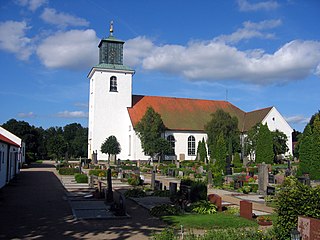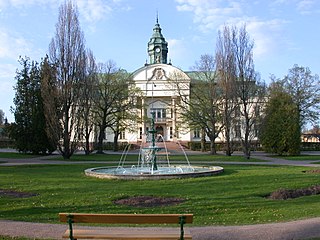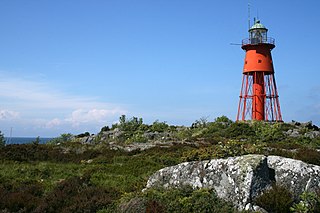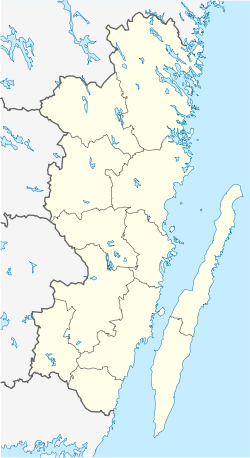
Sweden is a country in Northern Europe on the Scandinavian Peninsula. It borders Norway to the west ; Finland to the northeast; and the Baltic Sea and Gulf of Bothnia to the south and east. At 450,295 km2 (173,860 sq mi), Sweden is the largest country in Northern Europe, the fifth largest in Europe, and the 55th largest country in the world.

Värmland County is a county or län in west central Sweden. It borders the Swedish counties of Dalarna, Örebro and Västra Götaland, as well as the Norwegian counties of Østfold, Akershus and Innlandet to the west. Prince Carl Philip is Duke of Värmland.

Örebro is the sixth-largest city in Sweden, the seat of Örebro Municipality, and capital of Örebro County. It is situated by the Närke Plain, near the lake Hjälmaren, a few kilometers inland along the small river Svartån, and has a population of approximately 126,000 in the city proper. It is one of the largest inland hubs of the country, and a major logistic and commercial operating site.

Gällivare is a locality and the seat of Gällivare Municipality in Norrbotten County, province of Lapland, Sweden with 8,449 inhabitants in 2010. The town was founded in the 17th century. Together with nearby towns Malmberget and Koskullskulle it forms a conurbation with some 15,000 inhabitants. This conurbation is the second northernmost significant urban area of Sweden after Kiruna.

Osby is a locality and the seat of Osby Municipality, Scania County, Sweden with 7,157 inhabitants in 2010.

Mariestad is a locality and the seat of Mariestad Municipality, Västra Götaland County, Sweden. It had 16,611 inhabitants in 2019. Until 1997 it was the capital of the former Skaraborg County and an episcopal see in the Church of Sweden between 1583 and 1646.

Motala is a locality and the seat of Motala Municipality, Östergötland County, Sweden with 43,717 inhabitants in 2024. It is the third largest city of Östergötland, following Linköping and Norrköping. Motala is situated on the eastern shore of Lake Vättern and is regarded as the main centre of both the Göta Canal and the surrounding lake region.

Hagfors is a locality and the seat of Hagfors Municipality, Värmland County, Sweden with 10,125 inhabitants in 2010.

Skanör med Falsterbo is a statistical locality, situated in Vellinge Municipality, Skåne County, Sweden with 6,937 inhabitants in 2010. It consists of the two old towns of Skanör and Falsterbo which have grown together and were unified in 1754, but are still regarded as different communities by locals. The preposition med means with. Thanks to its southerly and maritime position, the locality is the mildest in Sweden, with winter lows barely averaging frosts.

The climate of Romania is continental, transitioning into humid subtropical on the eastern coast, influenced by polar intrusions, and therefore characterized by harsh winters. The mountain ranges of the Carpathian arc have a cool mountain climate with high humidity throughout the year.

Landsort is a Swedish village with a lighthouse on the island of Öja. The village has around 30 permanent residents.

Svenska Högarna is a small group of islands and a lighthouse located east of Möja in the Stockholm archipelago.

Gäddede is a locality in Strömsund Municipality, Jämtland County, Sweden with 401 inhabitants in 2010. It is located in the far north-western corner of the municipality and it is more than 100 kilometres (62 mi) to the locality of Strömsund by road. Gäddede is located a mere 5 kilometres (3.1 mi) from the Norway-Sweden border.

Ritsem is a village in the Gällivare Municipality, Norrbotten County, Sweden. It is located in the Stora Sjöfallet National Park. The area falls within the Swedish Lapland, and is home to the Sámi people during the reindeer migration. The town contains a 320 megawatt hydroelectric power plant, which sits inside a 16 km artificial tunnel connecting lake Sitasjaure to the Akkajaure reservoir. There is also a mountain cabin and caravan camp run by the Swedish Tourist Association.

The south of Sweden has a temperate climate, despite its northern latitude, with largely four distinct seasons and mild temperatures throughout the year. The winter in the far south is usually weak and is manifested only through some shorter periods with snow and sub-zero temperatures, autumn may well turn into spring there, without a distinct period of winter. The northern parts of the country have a subarctic climate while the central parts have a humid continental climate. The coastal south can be defined as having either a humid continental climate using the 0 °C isotherm, or an oceanic climate using the –3 °C isotherm.

Måseskär is a rocky island and a lighthouse station located in the sea of Skagerrak on the west coast of Sweden.

The South Swedish highlands or South Swedish Uplands are a hilly area covering large parts of Götaland in southern Sweden. Except for a lack of deep valleys, the landscape is similar to the Norrland terrain found further north in Sweden. The central-eastern parts of the highlands contain about thirty narrow canyons locally known as skurus.
The summer of 2014 in Sweden was unusually warm, especially in the northern parts of the country. July was the warmest ever month on record in the north-west.
Sweden had a very unusual start and finish to the year 2010, with two consecutive winter cold waves occurring in a single calendar year. Since both events were notable, both are covered in this article.

Bjuröklubb is a peninsula hosting a lighthouse and a nature reserve on the Bothnian Bay in Skellefteå Municipality in Västerbotten County in northern Sweden.





















